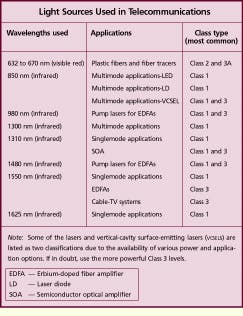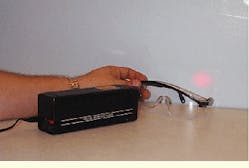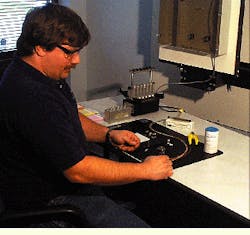On-the-job safety does not just happen. It should be planned for and practiced regularly.
Larry Johnson
The Light Brigade Inc.
When was the last time you checked your company`s safety program to see if it included fiber optics? In many organizations, fiber-optic safety is not given the emphasis it deserves. A quick quiz can help you assess your knowledge in this vital area (answers on page 40).
1. Which classification of light source is "eye-safe"?
2. Which electrical safety standards apply to indoor fiber-optic installations?
3. What are the latest editions of those standards?
4. By law, what document must accompany hazardous chemicals?
5. What is the best tool for removing fiber splinters?
6. What type of surface is best for working with optical fibers?
7. Which wavelength is the most dangerous to the eye: 850-, 1300-, or 1550-nanometer?
If you scored 7, you have an excellent knowledge of fiber-optic safety. A score of 5 or 6 shows a good knowledge, but some improvement is needed. With a score of 3 or 4, you`re not hopeless, but you are an insurance liability. If your score is 2 or lower, you`d better call in sick--it`s safer!
The quiz addresses several issues relating to fiber-optic safety: optical light sources and eye safety, fiber handling, and chemicals.
Light sources and eye safety
Through the years, light sources have been developed that operate at various wavelengths and power levels. Optical-fiber systems operate with three of these light sources:
light-emitting diodes (leds)
lasers
vertical-cavity surface-emitting lasers (vcsels).
Variations of these three devices are also used. These include the Fabry-Perot and distributed-feedback lasers, as well as surface- and edge-emitting leds. In addition, optical amplifiers--including the semiconductor optical amplifier (soa) and the more common erbium-doped fiber amplifier--are widely used to amplify optical signals.
In North America, the predominant standard for eye safety when using optical-fiber communications systems is the ansi z136.2 standard. Published by the Laser Institute of America in 1988, the standard was revised in 1997 (see "Regulating laser safety," page 36).
Light detection
Of the various instruments used to detect light output, the most common is the optical-power meter, which has a photodetector that detects and measures optical power at various wavelengths. Other light-detecting instruments are photosensor cards, which can detect and respond visually to light if they have been properly charged, and infrared viewers, which convert infrared light in the 800- to 1300-nm region to visible light. Infrared viewers are used predominantly for inspecting the output patterns of optical sources. All fibers should be assumed to be active. Therefore, never look into a transmitter or connector port.
Microscopes allow the user to see the end of the fiber surface but do not detect the infrared light exiting the fiber. For the user, good inspection microscopes are those that operate at 200- to 400-power magnification, which is adequate for viewing the fiber`s endface for quality-control purposes. The microscopes collimate the light beam and focus it into the eye. Although the microscopes magnify the image, they do not amplify the optical-power level. These instruments generally include a laser filter, which can decrease the optical level 2 to 35 decibels, depending on the wavelength being viewed.
Although they cost more, microscopes with 200- to 400-power magnification are a good investment not only for better inspection purposes but for visual safety as well. The buyer should always ask for a microscope with a filter and should know its specifications.
The less-expensive 30- to 100-power microscopes included in many fiber kits do not have any filter at all. Thus, they create the greatest opportunity for accidental eye damage and are not recommended for either quality-control or safety purposes. To avoid eye damage, the user should always wear laser-safe safety glasses when viewing optical fiber through such a microscope.
Fiber-handling issues
Most optical communications systems use glass fiber with an external coating that provides strength, improves ease of handling, and allows the manufacturer to color-code the fiber for visual identification. During connectorization or splicing, the coating is removed to allow fiber alignment with tightly controlled tolerances. Several safety issues arise during stripping of the coating, including proper tool usage, chemicals, fiber handling, and disposal of fiber debris. Once its protective coating has been removed, the fiber can be easily broken during the termination process. The likelihood of the fiber penetrating the skin is greatest at this time. For this reason, a properly equipped, safe work environment is highly desirable.
Work surfaces that provide contrast with the fiber being worked on create a better and safer work environment for the fiber technician. Work mats and tables are available for purchase through many sources. For laboratories and manufacturing environments, a work surface with a nonreflective black, chemical-resistant surface is recommended. The table should be easy to clean and designed so that fiber chips cannot accumulate in seams and around the edges.
For field use, lightweight, nonreflective black work mats are available that can be folded and kept in a toolbox. As with any item that a technician uses in the field, light weight and portability are key.
Another option for the technician is the fiber work table, which is available in three sizes. For the technician working in telecommunications closets, a small, lightweight table is best. For those working with splicing and cable preparation, longer tables with variable height settings work best. Other desirable features are good illumination, magnifying glasses, grounding clamps, and cable tie-offs for securing the cables.
Well-lit work areas allow for better and safer workmanship. Gooseneck lamps work well in both laboratory and field applications. Nonreflective work surfaces ensure that lighting does not strain the eyes and will reflect off discarded or misplaced fiber chips.
Safety glasses
When working with Class 3 lasers, the technician should wear safety eyewear with appropriate wavelength filters. Technicians who work with vcsels at the component level should wear safety glasses designed for the 850-nm window. In addition, they should specify the optical density (O.D.) level for the amount of attenuation needed in the application. For example, an O.D. of 1 equals 10 dB of attenuation; an O.D. of 2 would have an attenuation factor of 100 dB, and so forth. By knowing the optical output level of the source, the O.D. level can be specified to bring the source down to acceptable and safe limits.
For fiber-handling, standard safety glasses are a good idea, especially when connectorizing and splicing. These glasses can prevent fiber fragments from entering the eye during normal operations. But if you have fiber chips on your fingers, simple functions like rubbing your eyes would defeat the purpose of the safety glasses. Since fiber chips are small and transparent, it is likely that such debris can stick to skin oils. For this reason, it is best to clean your hands periodically to prevent fibers from being accidentally transferred to your eyes. Do not overlook the comfort of the eyewear because the technician in the field or lab may be required to wear the glasses for long periods of time.
Proper disposal of debris
Fiber chips should always be properly handled and disposed. Technicians should place fiber debris in special safety containers, such as small capped bottles, until it can be disposed properly.
When discarding fiber debris in trash cans, take these precautions:
Line the trash can with a disposable bag.
Clearly label the can: contains glass debris.
Do not compress the contents.
Seal the original bag within a second bag and seal that also.
Disposal of all fiber and related cable debris is the responsibility of the contractor, and this function should be written into the work order, request-for-quotation, or contract. Fiber chips should never be disposed under raised floors, where they could injure an unsuspecting technician working there later.
Even with proper precautions, everyone who works with optical fiber will eventually get a fiber splinter. When that happens, what can be done about it? First of all, most of these events happen during connectorization and splicing, since this is when the fiber is exposed to the handler. Coated fibers rarely penetrate the skin, but when the fibers have been stripped of their coating, this increases the likelihood of their breaking and penetrating the skin. Tweezers with Teflon-coated tips are good for grasping the uncoated fiber and removing it from the skin. Teflon-coated tweezers have a softer surface than steel tweezers, which may break the fiber, leaving a shard in your skin.
Chemicals in the workplace
Like many other industries, the fiber-optics industry uses a variety of chemicals. Some cables include moisture-repellent gels; many connectors use ultraviolet, anaerobic, and thermal cure epoxies to bond the fibers in place; mechanical splices have index-matching fluids and gels; and alcohol and other solutions are used to clean optical fibers. In addition to these chemicals, many lubricants are used when pulling cable through duct.
When sold, all of these materials must be accompanied by a technical bulletin known as a Material Safety Data Sheet (msds). Part of the "right-to-know" laws, msds requirements originated from the U.S. Department of Labor`s Occupational Safety and Health Administration`s Hazard Communication Standard, which was released in 1985. msds sheets include detailed information about the manufacturer of the chemical; hazardous ingredients contained in the chemical; physical data, fire, and explosion information; health hazards; reactivity data; spill and reactivity procedures; and any special protection and precautions required when using the chemical.
When ordering chemicals or materials that contain chemicals, always request that msds sheets accompany the shipment. In addition, a set of msds sheets should be handy wherever the work is being performed, not just in the office.
Eating and drinking should never be allowed around a fiber work area. It is best to eat and drink away from the working environment, and remember always to wash your hands after working with fibers or chemicals.
While there are many workplace safety regulations, they are effective only when each person in the organization abides by them. It takes one person to create a safety problem, and it takes just one to prevent a similar problem. Practicing safety requires a full-time commitment from everyone in the workplace.
A laser beam passes through standard safety glasses (left)...
A fiber technician works in a safe work area, which includes a non-reflective work surface and a container for disposal of fiber debris.
Regulating laser safety
The main document regulating laser use in optical-fiber communications systems is the ansi Z136.2 standard, "For the safe use of optical fiber communication systems utilizing laser diode and led sources." Major contributors to the standard are the U.S. Department of Health and Human Services, the National Center for Devices and Radiological Health, the U.S. Department of Labor`s Occupational Safety and Health Administration, and the National Institute for Occupational Safety and Health.
ansi Z136.2 is intended for manufacturers, installers, and service personnel. It provides guidance for optical-fiber communications systems with power levels of less than 500 milliwatts and wavelengths between 400 nanometers and 1 millimeter. This range covers components in field instruments, including the optical time-domain reflectometer. The standard addresses four classifications of lasers as well as four tiers of safety groups, which classify appropriate controls. Since fiber-optic systems confine the optical signal within the core of the fiber, the signal is accessible to the user only during connect/disconnect and inspection functions.
With the low power levels of most light-emitting diodes and lasers, most fiber communications are Class 1 systems--those incapable of producing high optical levels during normal operations and maintenance. Class 2, or low-power, sources operate in the visible spectrum (400 to 700 nm). Used in both plastic-optical-fiber networks and visible tracers, these sources should be viewed only under controlled conditions; in other words, don`t look directly into the light source. Class 3, or medium-power, sources require measures to prevent exposure to the direct beam. Many fiber systems, including high-power laser diodes, optical amplifiers, and visible lasers, are Class 3B and should never be viewed directly. Class 4 lasers are used in industrial, medical, and many military applications but not in fiber-optic communications systems, yet these are the lasers most people associate with extreme power levels.
Laser-related regulations are also included in Sections 1002, 1010, and 1040.10 of 21 cfr of the U.S. Food and Drug Administration`s Federal Code of Regulations. The applicable European standards are iec 825-1 and -2, which differ from the U.S. standard.
Fiber-optic safety resources
For fiber-optic safety videos, cd-roms, classes, and work tables, contact The Light Brigade Inc. at tel: (425) 251-1240 or by e-mail: [email protected].
For fiber-optic safety kits, tweezers, and safety mats, contact Clauss Cutlery Co. at tel: (419) 332-7344 or by e-mail: www.claussco.com.
Laser safety glasses can be obtained from Uvex Safety Inc. at tel: (800) 343-3411 or fax: (401) 232-1830.
Infrared viewers are available from Electrophysics Corp. at tel: (973) 882-0211 or www.electrophysics.com
Larry Johnson is president of The Light Brigade Inc. (Kent, WA). For more information, see www.lightbrigade.com.



